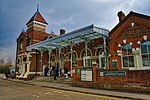Thorndike Theatre
Grade II listed buildings in SurreySurrey building and structure stubsTheatre companies in EnglandTheatres in SurreyUnited Kingdom theatre (structure) stubs ... and 1 more
Use British English from July 2020

The Thorndike Theatre is a Grade II listed building in Leatherhead, Surrey, England. Roderick Ham designed the theatre within the shell of the disused 1930s Crescent Cinema. Named after Dame Sybil Thorndike, the theatre was opened on 17 September 1969 by Princess Margaret.The theatre closed in 1997 after the loss of public funding. A charitable trust was set up to operate it and the theatre re-opened as the Leatherhead Theatre in 2001, with seating reduced to 495 plus three wheelchair places.
Excerpt from the Wikipedia article Thorndike Theatre (License: CC BY-SA 3.0, Authors, Images).Thorndike Theatre
High Street, Mole Valley
Geographical coordinates (GPS) Address Nearby Places Show on map
Geographical coordinates (GPS)
| Latitude | Longitude |
|---|---|
| N 51.295074 ° | E -0.328706 ° |
Address
Prive London
High Street
KT22 8AB Mole Valley
England, United Kingdom
Open on Google Maps







